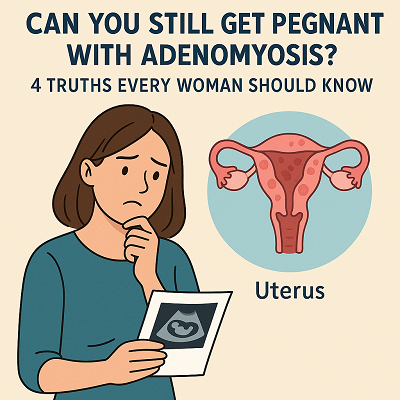Can You Still Get Pregnant with Adenomyosis? 4 Truths Every Woman Should Know
"Doctor, can I still have my baby?" In the consultation room, 29-year-old Mary clutched her ultrasound report, with her voice trembling. She had just received an adenomyosis diagnosis, which unfamiliar medical term doused her hopes of conception like a bucket of ice water. Statistics indicate that adenomyosis affects 20%-35% of women of reproductive age, with rising incidence among younger populations. Today, we are going to unveil the mysterious mask of this "invisible fertility threat."

Understand the Adenomyosis: It's Not Just About Dysmenorrhea
Adenomyosis is also named a "living cancer." When endometrial tissue abnormally invades the uterine muscle layer, it's like planting countless "time bombs" inside the uterus. The patients often experience:
- Progressive worsening of dysmenorrhea (requiring strong analgesics in severe cases)
- Heavy menstrual bleeding and prolonged duration (necessitating sanitary pad changes every 2 hours)
- Sexual intercourse and defecation pain
- Ultrasound's findings of diffusely enlarged uterus
Notably, the symptoms of adenomyosis are similar to those of endometriosis and uterine fibroids, etc., and they can be easily confused. For instance, endometriosis can also cause dysmenorrhea. However, the pain usually occurs 1-2 days before the onset of menstruation, reaching its peak on the first day of menstruation and gradually subsiding thereafter, while the dysmenorrhea caused by adenomyosis tends to worsen continuously as the disease progresses. Accurate diagnosis can only be made through detailed gynecological examinations, ultrasound examinations, and serum CA-125 tests, among others.
More concerningly, approximately 40% of patients will encounter fertility problems. The ectopic endometrial tissue not only alters the microenvironment of the uterus but also triggers chronic inflammation, forming a "fortress-like barrier" that hinders the implantation of the fertilized egg.
When Adenomyosis Meets Fertility: These 4 Key Challenges Need to be Overcome
The quality of the soil has declined. The fibrosis of the uterine muscle layer is like soil becoming compacted. Even if the embryo implants, it may still result in miscarriage due to insufficient nutrient supply. Data shows that the natural miscarriage rate among patients with adenomyosis is as high as 35% to 50%.
The fallopian tubes are blocked. The enlarged uterus may press on the fallopian tubes, just like setting up roadblocks on the "life passage," preventing the meeting of sperm and egg.
Endocrine imbalance. The accompanying hormonal disorders can lead to ovulation disorders, much like disrupting the "biological clock" for conception.
Immune dysfunction attack. Abnormal immune responses may attack the embryo as an "invader," and this phenomenon occurs in up to 62% of patients with adenomyosis.
5 Paths for Preparing for Pregnancy Resulting from Medical Advances
1. Drug treatment
GnRH-a-type drugs (such as leuprorelin) can temporarily induce an "artificial menopause" state, causing the ectopic endometrium to atrophy. However, it should be noted that the use of these drugs should not exceed 6 months, and after discontinuation, a 3-6 month golden window for conception should be seized.
2. Treatment with TCM Fuyan Pill
The traditional Chinese medicine "Fuyan Pill" can effectively eliminate inflammation within the uterus and improve the micro-environment of the uterus. Its blood-activating properties enhance pelvic circulation, soften the proliferated and hardened uterine muscle layer tissue caused by adenomyosis, alleviate the degree of uterine muscle layer fibrosis, and create more favorable conditions for embryo implantation. Meanwhile, by regulating the overall functions of the human body, Fuyan Pill can also correct the endocrine disorders caused by adenomyosis, restore normal hormone levels, and promote normal ovulation.
3. Surgical Treatment
For focal adenomyomas, laparoscopic lesion resection surgery maximizes fertility preservation. Recent studies indicate that pregnancy success rates within one year post-operation can reach 45%-65%. However, surgical intervention carries inherent risks, including potential complications such as postoperative pelvic adhesions and uterine rupture. Therefore, a comprehensive preoperative assessment of the patient's physical condition by a physician is essential.
4. Conceiving with Adenomyosis
Patients with mild disease (uterine volume < 8 gestational weeks; CA125 < 35 U/ml) may attempt conception directly under medical supervision. Crucially, successful pregnancy itself constitutes natural "adenomyosis therapy," as the high-progesterone environment during lactation significantly shrinks lesions. Nevertheless, during pregnancy with existing adenomyosis, patients require regular prenatal examinations to closely monitor uterine and fetal conditions. Once an abnormality occurs, appropriate treatment measures should be taken promptly.
5. Assisted Reproductive Technology
When natural conception proves difficult, in vitro fertilization (IVF) becomes a critical option. Clinical data demonstrate cumulative live birth rates of 40%-55% for adenomyosis patients through IVF. The precise timing of embryo transfer is paramount. Before IVF initiation, physicians typically administer pretreatment for adenomyosis, such as pharmacological reduction of uterine volume and endometrial environment optimization – to enhance embryo implantation rates and pregnancy success probabilities.
Contraceptive Tips: These 4 Things Are More Important Than Taking Medication
Seize the golden period of 25-30 years old: For every 1-year increase in age, the pregnancy success rate of patients with adenomyosis decreases by 7%-12%. It is recommended to formulate a fertility plan as soon as a diagnosis is confirmed.
New Insights on Weight Management: Maintaining a BMI between 18.5 and 23.9 and keeping the body fat percentage at 22% to 25% can not only preserve normal endocrine functions but also prevent fat cells from producing excessive estrogen that could stimulate the lesion.
Emotional Regulation Technology: Stress can increase cortisol levels in the body by three times, which can directly affect the quality of eggs. 15 minutes of mindfulness meditation every day, combined with 2 sessions of aerobic exercise per week, can significantly increase the chances of conception. In addition, you can also release stress by writing in a diary or sharing with friends, maintaining an optimistic attitude.
Dietary Adjustments also Offer Assistance: In terms of diet, patients with uterine adenomyosis should follow the principles of simplicity and balanced nutrition. They should consume more fresh vegetables and fruits rich in vitamins and minerals, such as spinach and apples, which can help enhance the body's immunity. Moderately consuming foods rich in protein, such as lean meat, fish, and beans, can provide sufficient energy for the body.
At the same time, they should avoid consuming spicy, greasy, and irritating foods, as well as foods containing estrogen, such as royal jelly and soy products, to prevent stimulating the growth of the lesion.
How Reliable Is Uterus-Preserving Surgery for Adenomyosis?
previous pageManaging Adenomyosis: Easing Pelvic Pain and Heavy Menstrual Bleeding with Natural Approaches
next page- Herbal Treatment for Adenomyosis with Large Uterine Enlargement and Heavy Bleeding
- Adenomyosis Dysmenorrhea: A Practical Guide to Topical Traditional Chinese Medicine Methods
- Effective Chinese Herbal Remedies for Adenomyosis Pain: End Your Period Discomfort
- Adenomyosis with Unbearable Cramps: When Painkillers Don't Work—Natural Relief with Fuyan Pill
- Managing Adenomyosis: Easing Pelvic Pain and Heavy Menstrual Bleeding with Natural Approaches
Testimonials
- Adenomyosis with Ureaplasma Urealyticum Cured by Fuyan Pill
- Tubal blockage with hydrosalpinx can be cured by TCM shortly
- Fuyan Pill Helps A woman with Adenomyosis Get Pregnant
- A Woman with Hydrosalpinx Is Cured with Fuyan pill
- Pelvic Inflammatory Disease Testimonials
- Irregular Vaginal Bleeding and Endometrial Thickening Cured by Fuyan Pill
- Pruritus Vulvae and Frequent Urination: Mycoplasma Infection Cured after 2 Courses



